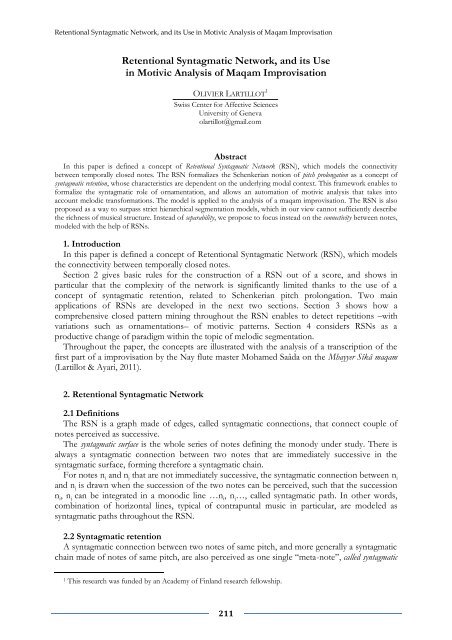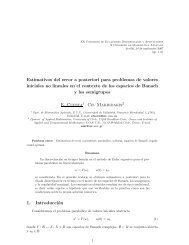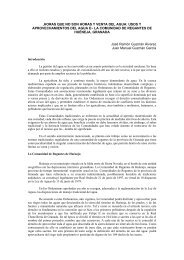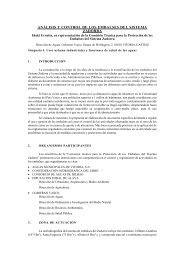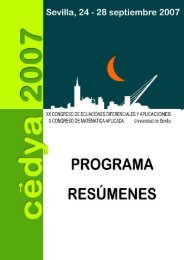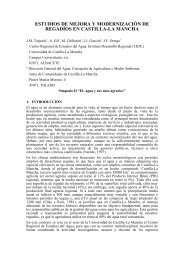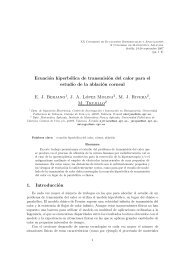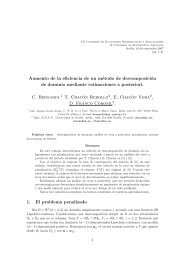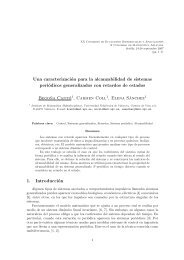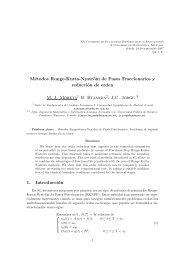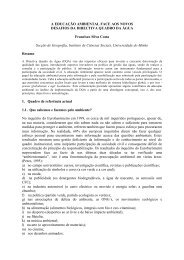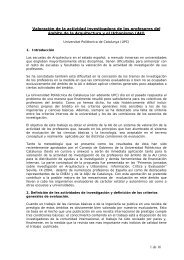LIBRO DE ACTAS (pdf) - Universidad de Sevilla
LIBRO DE ACTAS (pdf) - Universidad de Sevilla
LIBRO DE ACTAS (pdf) - Universidad de Sevilla
Create successful ePaper yourself
Turn your PDF publications into a flip-book with our unique Google optimized e-Paper software.
Retentional Syntagmatic Network, and its Use in Motivic Analysis of Maqam Improvisation<br />
Retentional Syntagmatic Network, and its Use<br />
in Motivic Analysis of Maqam Improvisation<br />
OLIVIER LARTILLOT 1<br />
Swiss Center for Affective Sciences<br />
University of Geneva<br />
olartillot@gmail.com<br />
Abstract<br />
In this paper is <strong>de</strong>fined a concept of Retentional Syntagmatic Network (RSN), which mo<strong>de</strong>ls the connectivity<br />
between temporally closed notes. The RSN formalizes the Schenkerian notion of pitch prolongation as a concept of<br />
syntagmatic retention, whose characteristics are <strong>de</strong>pen<strong>de</strong>nt on the un<strong>de</strong>rlying modal context. This framework enables to<br />
formalize the syntagmatic role of ornamentation, and allows an automation of motivic analysis that takes into<br />
account melodic transformations. The mo<strong>de</strong>l is applied to the analysis of a maqam improvisation. The RSN is also<br />
proposed as a way to surpass strict hierarchical segmentation mo<strong>de</strong>ls, which in our view cannot sufficiently <strong>de</strong>scribe<br />
the richness of musical structure. Instead of separability, we propose to focus instead on the connectivity between notes,<br />
mo<strong>de</strong>led with the help of RSNs.<br />
1. Introduction<br />
In this paper is <strong>de</strong>fined a concept of Retentional Syntagmatic Network (RSN), which mo<strong>de</strong>ls<br />
the connectivity between temporally closed notes.<br />
Section 2 gives basic rules for the construction of a RSN out of a score, and shows in<br />
particular that the complexity of the network is significantly limited thanks to the use of a<br />
concept of syntagmatic retention, related to Schenkerian pitch prolongation. Two main<br />
applications of RSNs are <strong>de</strong>veloped in the next two sections. Section 3 shows how a<br />
comprehensive closed pattern mining throughout the RSN enables to <strong>de</strong>tect repetitions –with<br />
variations such as ornamentations– of motivic patterns. Section 4 consi<strong>de</strong>rs RSNs as a<br />
productive change of paradigm within the topic of melodic segmentation.<br />
Throughout the paper, the concepts are illustrated with the analysis of a transcription of the<br />
first part of a improvisation by the Nay flute master Mohamed Saâda on the Mhayyer Sîkâ maqam<br />
(Lartillot & Ayari, 2011).<br />
2. Retentional Syntagmatic Network<br />
2.1 Definitions<br />
The RSN is a graph ma<strong>de</strong> of edges, called syntagmatic connections, that connect couple of<br />
notes perceived as successive.<br />
The syntagmatic surface is the whole series of notes <strong>de</strong>fining the monody un<strong>de</strong>r study. There is<br />
always a syntagmatic connection between two notes that are immediately successive in the<br />
syntagmatic surface, forming therefore a syntagmatic chain.<br />
For notes n i and n j that are not immediately successive, the syntagmatic connection between n i<br />
and n j is drawn when the succession of the two notes can be perceived, such that the succession<br />
n i, n j can be integrated in a monodic line …n i, n j…, called syntagmatic path. In other words,<br />
combination of horizontal lines, typical of contrapuntal music in particular, are mo<strong>de</strong>led as<br />
syntagmatic paths throughout the RSN.<br />
2.2 Syntagmatic retention<br />
A syntagmatic connection between two notes of same pitch, and more generally a syntagmatic<br />
chain ma<strong>de</strong> of notes of same pitch, are also perceived as one single “meta-note”, called syntagmatic<br />
1 This research was fun<strong>de</strong>d by an Aca<strong>de</strong>my of Finland research fellowship.<br />
211


